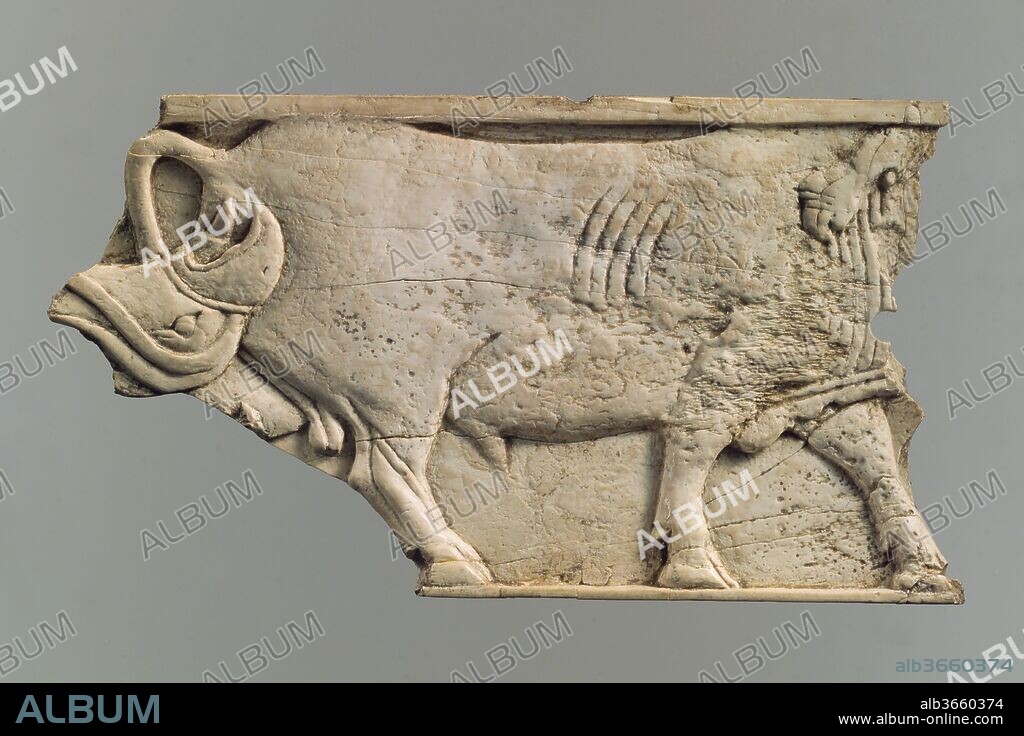alb3660374
Plaque Fragment

|
Ajouter à une autre Lightbox |
|
Ajouter à une autre Lightbox |



Avez-vous déjà un compte? S'identifier
Vous n'avez pas de compte ? S'inscrire
Acheter cette image

Titre:
Plaque Fragment
Légende:
Voir la traduction automatique
Plaque fragment. Culture: Assyrian. Dimensions: 3.86 x 7.01 x 0.28 in. (9.8 x 17.81 x 0.71 cm). Date: ca. 9th-8th century B.C..
This strip of ivory depicts a combat scene between animals, in which a griffin and a lion attack a bull. The bull's body entirely fills the space between the top and bottom border, but his head is not preserved. At the top right corner of the plaque, a lion's paw can be seen mauling the bull's neck. A griffin, an eagle-headed fantastic creature with the body of a lion, attacks the bull's hindquarters, and its lower beak is shown piercing the bull's flesh. Carved ivory pieces such as this were widely used in the production of elite furniture during the early first millennium B.C., and were often inlaid into a wooden frame using joinery techniques and glue. This fragment was clearly part of a larger carved strip, perhaps part of a chair or bed. The scene of energetic combat between real and fantastic animals is a common motif on ivories attributed to North Syrian workshops.
Built by the Assyrian king Ashurnasirpal II, the palaces and storerooms of Nimrud housed thousands of pieces of carved ivory. Most of the ivories served as furniture inlays or small precious objects such as boxes. While some of them were carved in the same style as the large Assyrian reliefs lining the walls of the Northwest Palace, the majority of the ivories display images and styles related to the arts of North Syria and the Phoenician city-states. Phoenician style ivories are distinguished by their use of imagery related to Egyptian art, such as sphinxes and figures wearing pharaonic crowns, and the use of elaborate carving techniques such as openwork and colored glass inlay. North Syrian style ivories tend to depict stockier figures in more dynamic compositions, carved as solid plaques with fewer added decorative elements. However, some pieces do not fit easily into any of these three styles. Most of the ivories were probably collected by the Assyrian kings as tribute from vassal states, and as booty from conquered enemies, while some may have been manufactured in workshops at Nimrud. The ivory tusks that provided the raw material for these objects were almost certainly from African elephants, imported from lands south of Egypt, although elephants did inhabit several river valleys in Syria until they were hunted to extinction by the end of the eighth century B.C.
Technique/matériel:
MARFIL
Période:
NEOASIRIO
Musée:
Metropolitan Museum of Art, New York, USA
Crédit:
Album / Metropolitan Museum of Art, NY
Autorisations:
Modèle: Non - Propriété: Non
Questions sur les droits?
Questions sur les droits?
Taille de l'image:
4155 x 2773 px | 33.0 MB
Taille d'impression:
35.2 x 23.5 cm | 13.9 x 9.2 in (300 dpi)
Mots clés:
 Pinterest
Pinterest Twitter
Twitter Facebook
Facebook Copier le lien
Copier le lien Email
Email
